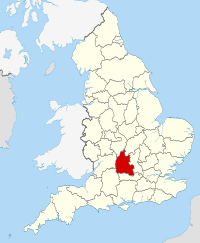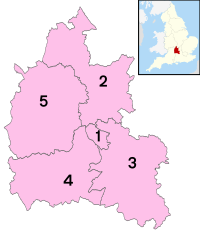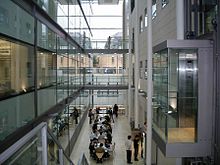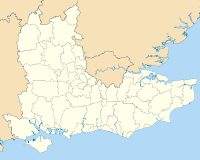Oxfordshire
This article needs additional citations for verification. (August 2016) |
Oxfordshire | |
|---|---|
| Motto: Sapere Aude ('Dare to be Wise')[1] | |
 | |
| Sovereign state | United Kingdom |
| Constituent country | England |
| Region | South East England |
| Time zone | UTC+0 (GMT) |
| • Summer (DST) | UTC+1 (BST) |
| UK Parliament | |
| Ceremonial county | |
| Area | 2,605 km2 (1,006 sq mi) |
| • Rank | 22nd of 48 |
| Population (2022)[2] | 738,276 |
| • Rank | 35th of 48 |
| Density | 283/km2 (730/sq mi) |
| Ethnicity | 95.1% White 1.7% S. Asian |
| Non-metropolitan county | |
| County council | File:Oxfordshire county council logo.jpg Oxfordshire County Council http://www.oxfordshire.gov.uk |
| Control | |
| Admin HQ | Oxford |
| Area | [convert: needs a number] |
| • Rank | of 21 |
| • Rank | of 21 |
| Density | [convert: needs a number] |
| ISO 3166-2 | GB-OXF |
| ITL | UKJ14 |
| Districts | |
 Unitary County council area Districts of Oxfordshire | |
| Districts | |
Oxfordshire (/ˈɒksfərdʃər/ or /ˈɒksfərdʃɪər/; abbreviated Oxon) is a county in South East England bordering on Warwickshire (to the north/north-west), Northamptonshire (to the north/north-east), Buckinghamshire (to the east), Berkshire (to the south), Wiltshire (to the south-west) and Gloucestershire (to the west).
The county has major education and tourist industries and is noted for the concentration of performance motorsport companies and facilities. Oxford University Press is the largest firm among a concentration of print and publishing firms; the University of Oxford is also linked to the concentration of local biotechnology companies.
The main centre of population is the city of Oxford. Other significant settlements are Banbury, Bicester, Kidlington and Chipping Norton to the north of Oxford; Carterton and Witney to the west; Thame and Chinnor to the east; and Abingdon, Wantage, Didcot, Wallingford and Henley-on-Thames to the south.
The highest point is White Horse Hill, in the Vale of White Horse, reaching 261 metres (856 ft).[3]
Oxfordshire's county flower is the Snake's-head Fritillary.[4]
History
Oxfordshire was recorded as a county in the early years of the 10th century and is situated on land between the River Thames to the south, the Cotswolds to the west, the Chilterns to the east and the Midlands to the north, with spurs running south to Henley-on-Thames and north to Banbury.
Historically the area has always had some importance, since it contains valuable agricultural land in the centre of the county. Largely ignored by the Romans, it was not until the formation of a settlement at Oxford in the eighth century that the area grew in importance. Alfred the Great was born across the Thames in Wantage, Vale of White Horse. The University of Oxford was founded in 1096, though its collegiate structure did not develop until later on. The university in the county town of Oxford (whose name came from Anglo-Saxon Oxenaford = "ford for oxen") grew in importance during the Middle Ages and early modern period. The area was part of the Cotswolds wool trade from the 13th century, generating much wealth, particularly in the western portions of the county in the Oxfordshire Cotswolds. Morris Motors was founded in Oxford in 1912, bringing heavy industry to an otherwise agricultural county. The importance of agriculture as an employer has declined rapidly in the 20th century though; currently under one percent of the county's population are involved due to high mechanisation. Nonetheless, Oxfordshire remains a very agricultural county by land use, with a lower population than neighbouring Berkshire and Buckinghamshire, which are both smaller.
Throughout most of its history the county was divided into fourteen hundreds, namely Bampton, Banbury, Binfield, Bloxham, Bullingdon, Chadlington, Dorchester, Ewelme, Langtree, Lewknor, Pyrton, Ploughley, Thame and Wootton.
The Oxfordshire and Buckinghamshire Light Infantry, the main army unit in the area, was based at Cowley Barracks on Bullingdon Green, Cowley.
The Vale of White Horse district and parts of the South Oxfordshire administrative district south of the River Thames were historically part of Berkshire, but were added to the administrative county of Oxfordshire in 1974. Conversely, the Caversham area of Reading, now administratively in Berkshire, was historically part of Oxfordshire as was the parish of Stokenchurch, now administratively in Buckinghamshire.
Economy
This is a chart of trend of regional gross value added of Oxfordshire at current basic prices published by the Office for National Statistics with figures in millions of British Pounds Sterling.[5]
| Year | Regional gross value added[6] | Agriculture[7] | Industry[8] | Services[9] |
|---|---|---|---|---|
| 1995 | 7,607 | 120 | 2,084 | 5,404 |
| 2000 | 10,594 | 80 | 2,661 | 7,853 |
| 2003 | 12,942 | 93 | 2,665 | 10,184 |
Politics
Oxfordshire County Council, currently controlled by a Conservative Independent Alliance, is responsible for the most strategic local government functions, including schools, county roads, and social services The county is divided into five local government districts: Oxford, Cherwell, Vale of White Horse (after the Uffington White Horse), West Oxfordshire and South Oxfordshire, which deal with such matters as town and country planning, waste collection, and housing.
In the 2016 European Union referendum, Oxfordshire was the only English county as a whole to vote to remain in the European Union by a significant margin, at 57.06% (70.27% in the City of Oxford), despite Cherwell (barely) voting to leave at 50.31%.
Education


Oxfordshire has a completely comprehensive education system with 23 independent schools and 35 state secondary schools. Only eight schools do not have a sixth form; these are mostly in South Oxfordshire and Cherwell districts.
The county has two universities: the ancient University of Oxford and the modern Oxford Brookes University, both located in Oxford. In addition, Wroxton College, located in Banbury, is affiliated with Fairleigh Dickinson University of New Jersey.
Buildings
The "dreaming spires" of the buildings of the University of Oxford are among the reasons for Oxford being the sixth most visited city in the United Kingdom for international visitors.[10] Among many notable University buildings are the Sheldonian Theatre, built 1664–68 to the design of Sir Christopher Wren, and the Radcliffe Camera, built 1737–49 to the design of James Gibbs.
Blenheim Palace close to Woodstock was built by the great architect John Vanbrugh for John Churchill, 1st Duke of Marlborough, after he had won the battle of Blenheim. The gardens, which can be visited, were designed by the landscape gardener "Capability Brown", who planted the trees in the battle formation of the victorious army. In the palace, which can also be visited by the public, Sir Winston Churchill was born in 1874.
Chastleton House, on the Gloucestershire and Warwickshire borders, is a great country mansion built on property bought from Robert Catesby, who was one of the men involved in the Gunpowder Plot with Guy Fawkes. Stonor Park, another country mansion, has belonged to the recusant Stonor family for centuries.
Mapledurham House is an Elizabethan stately home in the far south-east of the county, close to Reading.
Settlements in Oxfordshire

- Abingdon (in Berkshire until 1974)
- Banbury
- Bicester
- Burford
- Carterton
- Charlbury
- Chinnor
- Chipping Norton
- Didcot (in Berkshire until 1974)
- Faringdon (in Berkshire until 1974)
- Henley-on-Thames
- Islip
- Kidlington
- Oxford
- Thame
- Wallingford (in Berkshire until 1974)
- Wantage (in Berkshire until 1974)
- Watlington
- Witney
- Woodstock
Emergency services
- Oxfordshire Fire and Rescue Service
- Thames Valley Police
- British Transport Police
- South Central Ambulance Service
- Thames Valley Air Ambulance
Settlements by population
| Rank | Town | Population | Year | Definition | Notes |
|---|---|---|---|---|---|
| 1 | Oxford | 150,200 | 2011 | Oxford non-metropolitan district | |
| 2 | Banbury | 46,853 | 2011 | Civil parish | |
| 3 | Abingdon | 33,130 | 2011 | Civil parish | |
| 4 | Bicester | 32,642 | 2011 | Civil parish | |
| 5 | Witney | 27,522 | 2011 | Civil parish | |
| 6 | Didcot | 25,140 | 2011 | Civil parish | 200 dwellings in the southeast of the town lie in neighbouring East Hagbourne parish. |
| 7 | Carterton | 15,769 | 2011 | Civil parish | |
| 8 | Kidlington | 13,723 | 2011 | Civil parish | Does not include Gosford. |
| 9 | Henley-on-Thames | 11,619 | 2011 | Civil parish | |
| 10 | Thame | 11,561 | 2011 | Civil parish | Includes hamlet of Moreton |
| 11 | Wantage | 11,327 | 2011 | Civil parish | |
| 12 | Wallingford | 7,918 | 2011 | Civil parish | |
| 13 | Grove | 7,178 | 2011 | Civil parish | |
| 14 | Faringdon | 7,121 | 2011 | Great Faringdon civil parish | |
| 15 | Chipping Norton | 6,337 | 2011 | Civil parish | |
| 16 | Chinnor | 5,924 | 2011 | Civil parish | |
| 17 | Benson | 4,754 | 2011 | Civil parish | |
| 18 | Eynsham | 4,648 | 2011 | Civil parish | |
| 19 | Wheatley | 4,092 | 2011 | Civil parish | |
| 20 | Kennington | 4,076 | 2011 | Civil parish | |
| 21 | Woodstock | 3,100 | 2011 | Civil parish | |
| 22 | Charlbury | 2,830 | 2011 | Civil parish | |
| 23 | Watlington | 2,727 | 2011 | Civil parish | |
| 24 | Bampton | 2,564 | 2011 | Civil parish | |
| 25 | Burford | 1,410 | 2011 | Civil parish |
Places of interest
| Key | |
| Abbey/Priory/Cathedral | |
| Accessible open space | |
| Amusement/Theme Park | |
| Castle | |
| Country Park | |
| English Heritage | |
| Forestry Commission | |
| Heritage railway | |
| Historic House | |
| Places of Worship | |
| Museum (free/not free) | |
| National Trust | |
| Theatre | |
| Zoo | |
 Abingdon County Hall Museum[11] – housed in a 17th-century County Hall building
Abingdon County Hall Museum[11] – housed in a 17th-century County Hall building Ashdown House – 17th-century country house in the Lambourn Downs
Ashdown House – 17th-century country house in the Lambourn Downs Ashmolean Museum – Oxford University's museum of art and archaeology
Ashmolean Museum – Oxford University's museum of art and archaeology Banbury Museum, Banbury
Banbury Museum, Banbury- Bicester Village
 Blenheim Palace and garden – UNESCO World Heritage Site
Blenheim Palace and garden – UNESCO World Heritage Site Broughton Castle – 14th-century fortified manor house
Broughton Castle – 14th-century fortified manor house Buscot Park, Buscot – 18th-century country house and landscape garden
Buscot Park, Buscot – 18th-century country house and landscape garden Champs Chapel Museum of East Hendred – village museum in a 15th-century Carthusian chapel
Champs Chapel Museum of East Hendred – village museum in a 15th-century Carthusian chapel Charlbury Museum
Charlbury Museum Chastleton House – 17th-century country house (limited access)
Chastleton House – 17th-century country house (limited access) Chiltern Hills – Area of Outstanding Natural Beauty
Chiltern Hills – Area of Outstanding Natural Beauty Chinnor & Princes Risborough Railway – operated with steam and diesel locomotives
Chinnor & Princes Risborough Railway – operated with steam and diesel locomotives Chipping Norton Museum[12]
Chipping Norton Museum[12] Cholsey and Wallingford Railway
Cholsey and Wallingford Railway Cogges Manor Farm Museum, Witney – a living museum of country life
Cogges Manor Farm Museum, Witney – a living museum of country life Combe Mill Museum,[13] Long Hanborough – working museum of stationary steam engines
Combe Mill Museum,[13] Long Hanborough – working museum of stationary steam engines Cotswold Wildlife Park and garden, Bradwell Grove, Holwell
Cotswold Wildlife Park and garden, Bradwell Grove, Holwell Cotswolds – Area of Outstanding Natural Beauty
Cotswolds – Area of Outstanding Natural Beauty Didcot Railway Centre – museum of the Great Western Railway
Didcot Railway Centre – museum of the Great Western Railway Dorchester Abbey, Dorchester-on-Thames – 12th-century church of former Augustinian abbey
Dorchester Abbey, Dorchester-on-Thames – 12th-century church of former Augustinian abbey Great Coxwell Barn – 14th-century Tithe barn
Great Coxwell Barn – 14th-century Tithe barn Greys Court, Rotherfield Greys – 16th-century country house
Greys Court, Rotherfield Greys – 16th-century country house Hampton Gay Manor – ruins of 16th-century manor house (no website)
Hampton Gay Manor – ruins of 16th-century manor house (no website)- Harcourt Arboretum, Nuneham Courtenay
 Heythrop Hall – 17th-century country house: now a hotel, golf & country club
Heythrop Hall – 17th-century country house: now a hotel, golf & country club- Hook Norton Brewery – working Victorian "tower" brewery that offers guided tours
 Kelmscott Manor – Home of William Morris
Kelmscott Manor – Home of William Morris Mapledurham Estate – 16th-century country house and 15th-century watermill
Mapledurham Estate – 16th-century country house and 15th-century watermill Milton Manor House – 18th-century country house[14]
Milton Manor House – 18th-century country house[14] Minster Lovell Hall – dovecote and ruins of 15th-century manor house
Minster Lovell Hall – dovecote and ruins of 15th-century manor house Museum of Bygones, Claydon – private museum including stationary steam engines
Museum of Bygones, Claydon – private museum including stationary steam engines North Wessex Downs – Area of Outstanding Natural Beauty
North Wessex Downs – Area of Outstanding Natural Beauty


 Oxford
Oxford Oxford Bus Museum and Morris Motors Museum, Long Hanborough
Oxford Bus Museum and Morris Motors Museum, Long Hanborough Oxford Canal – 18th-century "narrow" canal
Oxford Canal – 18th-century "narrow" canal The Oxfordshire Museum, Woodstock
The Oxfordshire Museum, Woodstock The Ridgeway
The Ridgeway River and Rowing Museum, Henley-on-Thames
River and Rowing Museum, Henley-on-Thames River Thames
River Thames- Rollright Stones – megalithic stone circle and Whispering Knights burial chamber, near Little Rollright
 Rousham House – 17th-century country house and landscape garden
Rousham House – 17th-century country house and landscape garden- Rycote chapel – 15th-century chapel with original furnishings
- St Katharine's church, Chiselhampton – 18th-century parish church with original furnishings (no website, limited access)
- St Mary's church, Iffley – 12th-century Norman parish church[15]
 Shotover Country Park, Headington
Shotover Country Park, Headington Spiceball Country Park, Banbury
Spiceball Country Park, Banbury Stanton Harcourt manor house (limited access), with garden and 15th-century chapel and Pope's Tower (no website)
Stanton Harcourt manor house (limited access), with garden and 15th-century chapel and Pope's Tower (no website) Stonor House – country house and 14th-century chapel of the recusant Stonor family
Stonor House – country house and 14th-century chapel of the recusant Stonor family Swalcliffe Tithe Barn – 15th-century
Swalcliffe Tithe Barn – 15th-century Thame Museum
Thame Museum Tolsey Museum, Burford (no website)
Tolsey Museum, Burford (no website) Uffington White Horse, Uffington Castle and Wayland's Smithy burial chamber in the White Horse Hills
Uffington White Horse, Uffington Castle and Wayland's Smithy burial chamber in the White Horse Hills Vale and Downland Museum, Wantage
Vale and Downland Museum, Wantage Wallingford Museum
Wallingford Museum Wheatley Windmill – 18th-century tower mill[16]
Wheatley Windmill – 18th-century tower mill[16]
See also
- Lord Lieutenant of Oxfordshire
- High Sheriff of Oxfordshire
- Oxfordshire Artweeks, an annual art festival each May
- Oxford University (including links to the individual colleges)
- Oxford Canal
References and notes
- ^ "Camelot International, Britain's heritage and history". Camelotintl.com. Retrieved 9 November 2011.
- ^ "Mid-2022 population estimates by Lieutenancy areas (as at 1997) for England and Wales". Office for National Statistics. 24 June 2024. Retrieved 26 June 2024.
- ^ [1][dead link]
- ^ "Fritillary (Fritillaria meleagris)". Plantlife. Retrieved 17 August 2012.
- ^ "unknown" (PDF). pp. 240–253. Archived from the original (PDF) on 28 July 2011.
{{cite web}}: Cite uses generic title (help); Unknown parameter|deadurl=ignored (|url-status=suggested) (help) - ^ Components may not sum to totals due to rounding
- ^ includes hunting and forestry
- ^ includes energy and construction
- ^ includes financial intermediation services indirectly measured
- ^ "Economic Statistics". Oxford City Council. Retrieved 8 August 2016.
- ^ Christopher Gale (7 July 2012). "Abingdon County Hall Museum". Abingdonmuseum.org.uk. Retrieved 8 August 2016.
- ^ [2] [dead link]
- ^ "Home". Combemill.org. Retrieved 23 August 2014.
- ^ "Oxfordshire". Milton Manor House. Retrieved 23 August 2014.
- ^ Pevsner, Nikolaus; Sherwood, Jennifer (1974). The Buildings of England: Oxfordshire. Yale University Press. ISBN 978-0300096392.
- ^ Glitz. "Wheatley Windmill Website". Wheatleymill.co.uk. Retrieved 23 August 2014.
Further reading
- Powell, Philip (2005). The Geology of Oxfordshire. Dovecote Press. ISBN 1-904349-19-6.


